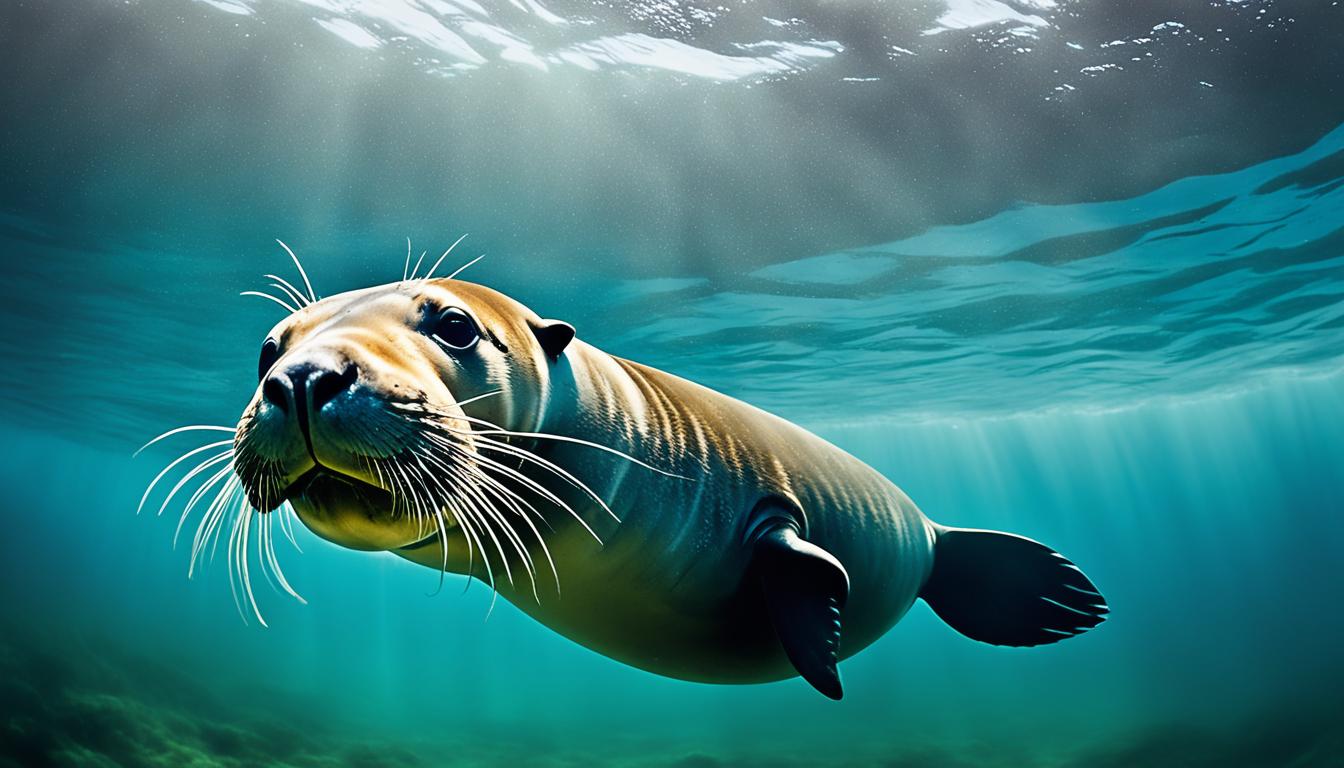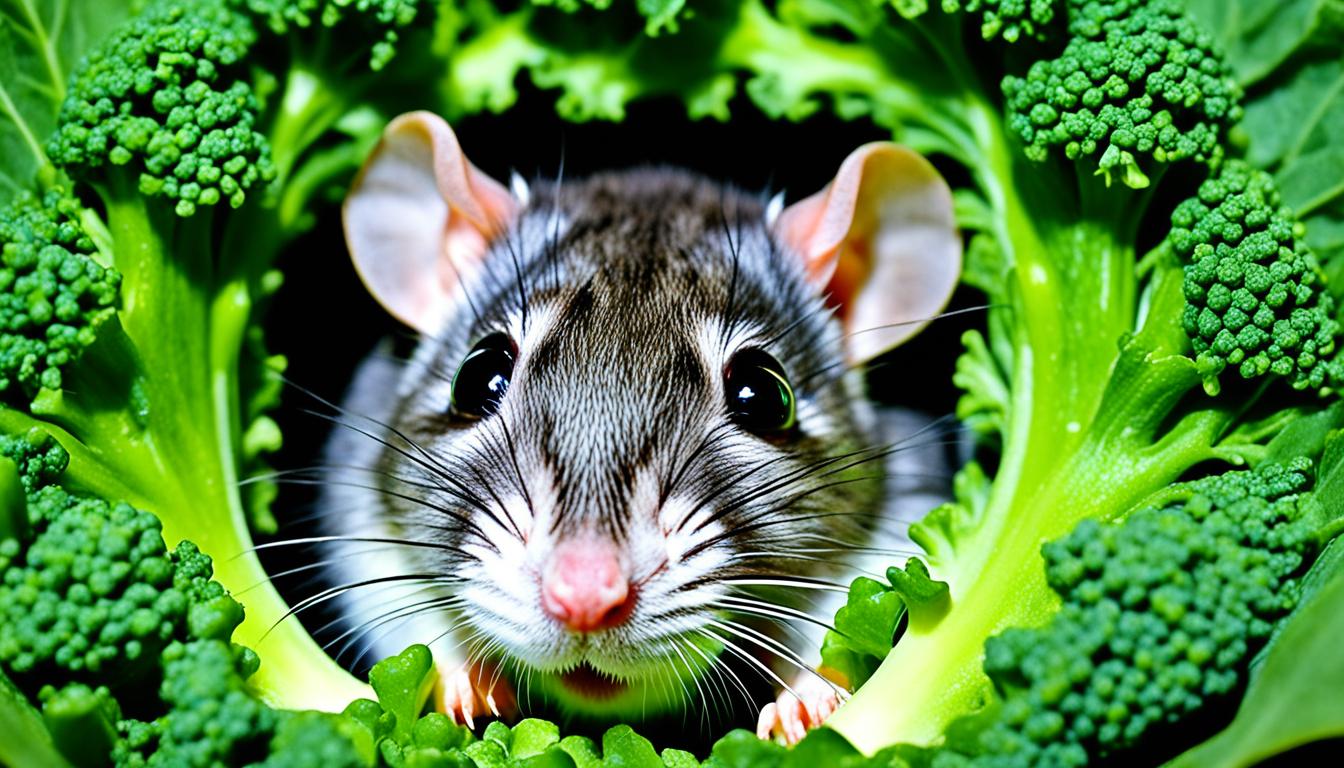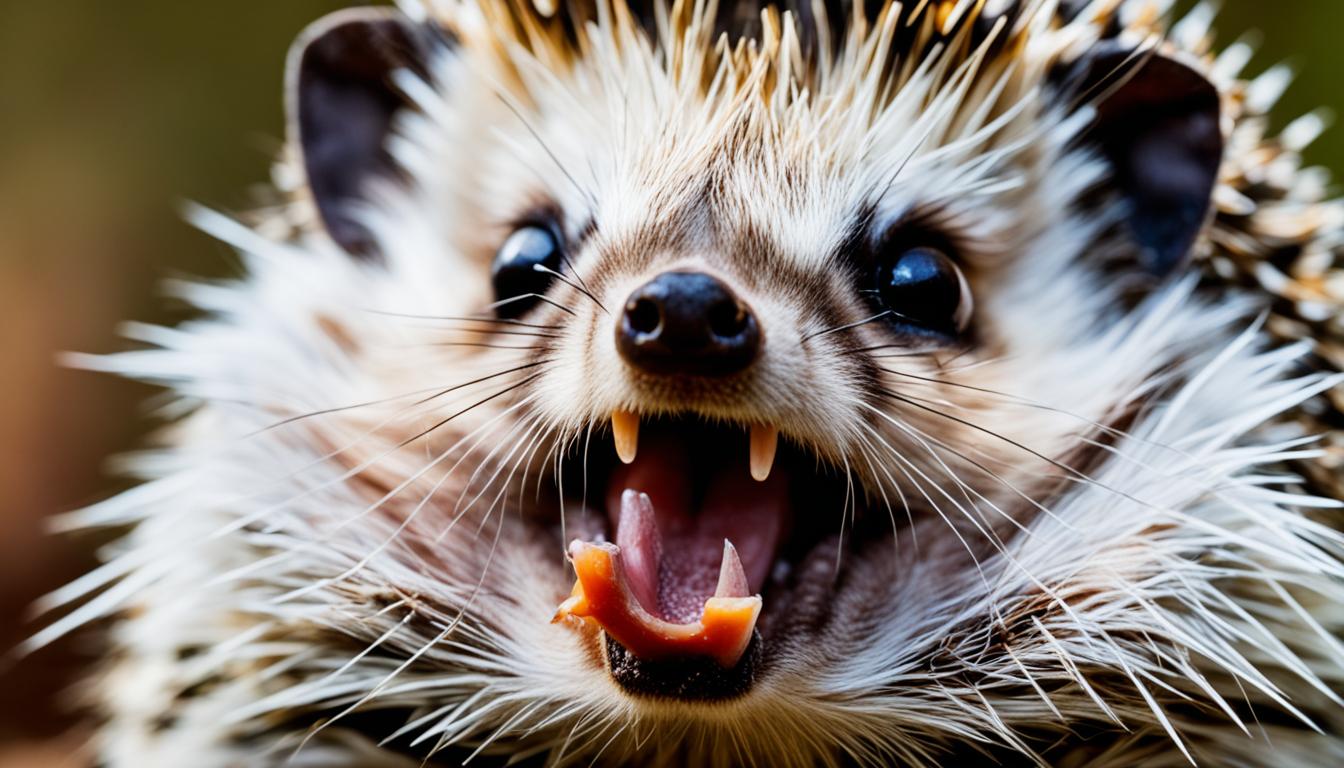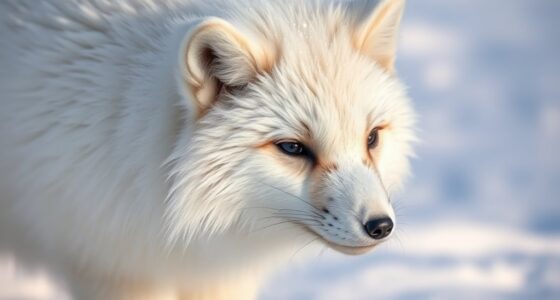**Sea lions** account for about 20% of all marine mammal bites reported in the United States. Despite being perceived as friendly and playful animals, it’s crucial to be aware of their **behavior** and the potential dangers of engaging with them. Dive into the world of **sea lion** **safety** to gain valuable knowledge and tips for a safe and delightful encounter. Experience the fascinating world of these creatures firsthand and learn how to protect yourself while enjoying their company.
Key Takeaways:
- Sea lions account for around 20% of reported marine mammal bites in the United States.
- Understanding sea lion behavior is crucial for ensuring safety during interactions.
- Sea lions are generally friendly, but caution is advised due to their size and potential for aggression when threatened.
- Maintaining a safe distance and respecting their space is vital to minimize risks.
- Follow expert guidelines when swimming with sea lions to avoid dangerous encounters.
What Makes the California Coast a Popular Habitat for Sea Lions?
Sea lions thrive along the beautiful California coastline, where they have found an idyllic habitat rich in resources and favorable conditions. Here, they can find an abundance of food and bask under the warm sun, making the California coast an ideal location for these charismatic marine mammals.
The California coast offers a habitat that caters to the dietary needs of sea lions. The waters here are teeming with fish and seafood, providing a plentiful and diverse food source. The nutrient-rich ecosystem supports a variety of species that sea lions rely on for sustenance, enabling them to thrive and grow.
Furthermore, the temperate climate along the California coast is perfectly suited for sea lions. The moderate temperatures and ample sunlight create a comfortable environment, both on land and in the water. The beaches provide an ideal resting place for these creatures, allowing them to bask and regulate their body temperature.
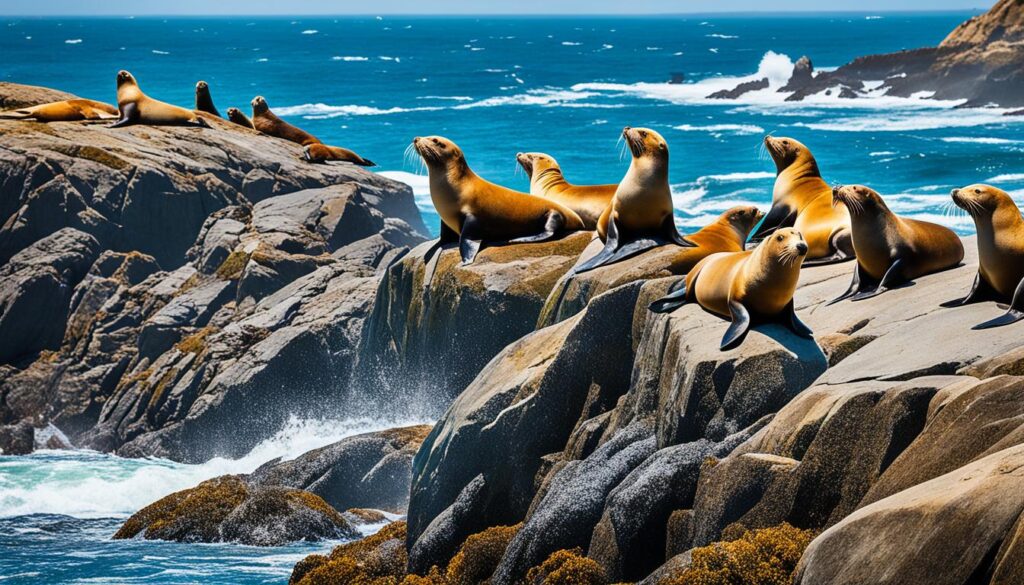
“The California coast is a haven for sea lions, offering a bountiful buffet of seafood and beaches perfect for sunbathing.”
In summary, the California coast’s unique combination of abundant food sources and favorable climate makes it an irresistible habitat for sea lions. It’s no wonder why these captivating creatures can be found frolicking along the golden shores, enjoying all that this coastal paradise has to offer.
Sea Lions vs. Seals: Differences Beyond Appearance
Although sea lions and seals may share some physical similarities, they have distinct characteristics that set them apart. Understanding these differences can help us appreciate the unique qualities of each marine mammal.
Sea lions, known for their larger size and impressive agility, have dark brown or tan fur and prominent ear flaps. They can move gracefully both on land and in water, using their front flippers to “walk” on land and efficiently swim and dive beneath the surface. Sea lions are truly remarkable creatures, displaying remarkable athleticism and adaptability.
On the other hand, seals have lighter-colored fur with grey spots and lack prominent ear flaps. Despite their seemingly less robust appearance, seals are well-suited to living in aquatic environments. They are excellent swimmers but are less adept at moving on land compared to sea lions. Seals prefer to use their hind flippers to navigate in water and often shuffle on their bellies when on land.
To summarize, the main differences between sea lions and seals lie in their size, fur coloration, ear flaps, and movement capabilities. While sea lions excel in their ability to navigate both land and water, seals are built for aquatic life but are less agile on land.
When Are Sea Lions Dangerous?
Sea lions are generally friendly and playful animals when interacting with humans. However, their massive size and weight can make them potentially dangerous in certain situations. Sea lions may display aggressive behavior if they feel threatened, fearful, or when protecting their young. While sea lion attacks are rare, caution and maintaining a safe distance is important when interacting with these mammals.
Aggressive Behavior in Sea Lions
Sea lions are known for their curious and social nature, often approaching humans out of curiosity. They may even playfully interact with snorkelers or divers. However, it’s important to remember that sea lions are wild animals and have their boundaries.
Sea lions may display aggressive behavior if they feel threatened, fearful, or when protecting their young.
When approached too closely or if they perceive a threat, sea lions can exhibit signs of aggression. These may include barking loudly, lunging towards you, or even biting or scratching. It’s essential to read their body language and adjust your behavior accordingly. Maintaining a safe distance shows respect for their space and reduces the risk of potential conflicts.
Staying Safe around Sea Lions
To ensure your safety and the well-being of the sea lions, here are some guidelines to follow:
- Observe from a distance: Admire sea lions from a distance of at least 50 yards. This distance allows you to appreciate their presence without intruding on their territory.
- Avoid sudden movements: Sudden movements can startle sea lions and may trigger defensive behavior. Maintain a calm and non-threatening presence.
- Don’t feed or touch them: Feeding or attempting to touch sea lions can alter their behavior and disrupt their natural feeding patterns. It’s important to let them find their own food sources.
- Leave sea lions alone during breeding season: Breeding season is a critical time for sea lions. Female sea lions can be protective, and disturbing them during this period can lead to aggressive responses.
Image
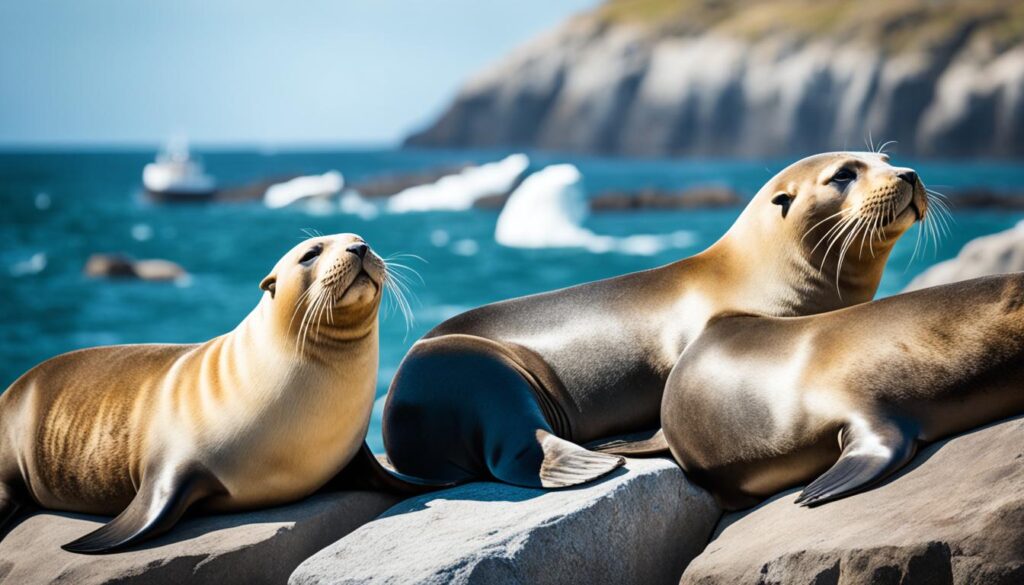
Predators & Threats to Sea Lions
Sea lions, like many other creatures, face various threats and predators in their natural habitats. Let’s take a closer look at some of the dangers that sea lions encounter:
1. Predators
In the ocean, sea lions have to watch out for two formidable predators:
| Predator | Description |
|---|---|
| Great White Sharks | Great white sharks are known for their powerful jaws and hunting skills. They see sea lions as a source of food and will often target them during their feeding expeditions. |
| Orcas | Orcas, also known as killer whales, are highly intelligent and skilled hunters. They use cooperative strategies to hunt down and prey upon sea lions. |
These predators pose a significant threat to sea lions, preying on them for survival.
2. Human Threats
Unfortunately, humans also contribute to the threats faced by sea lions:
- Hunting: In the past, sea lions were hunted by humans for their fur and meat. While such activities are now strictly regulated, illegal hunting still occurs, posing a danger to sea lion populations.
- Competition: Fishermen often view sea lions as competitors for fish, leading to conflicts between the two groups. In some cases, sea lions are shot or harmed by fishermen aiming to protect their catch.
- Environmental Impact: Human activities such as pollution and the improper disposal of waste can harm sea lions. For instance, marine debris, including fishing nets and hooks, can entangle and injure these marine mammals.
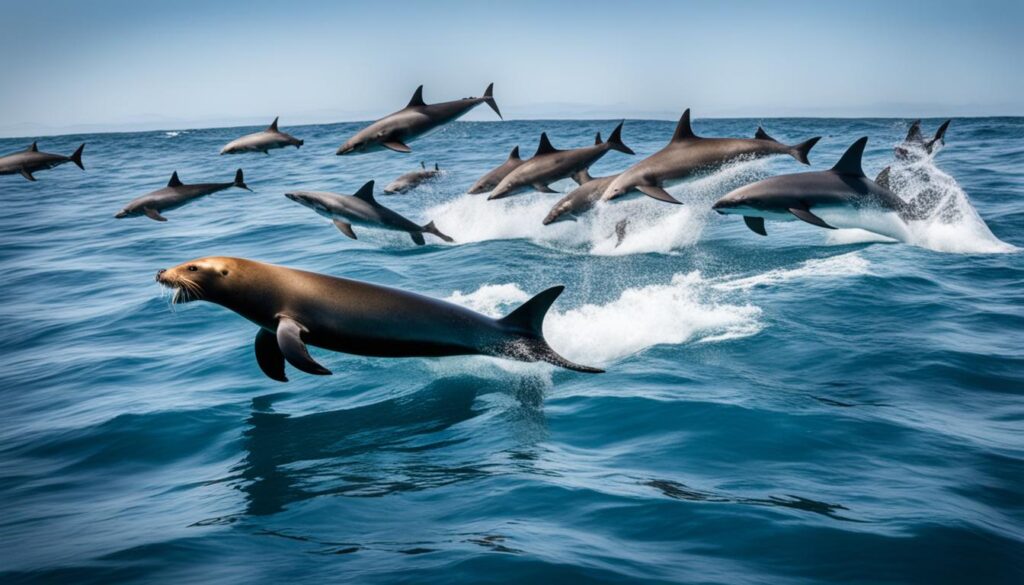
3. Vulnerability of Galapagos Sea Lions
Galapagos Sea Lions, a unique subspecies found in the volcanic islands of the Galapagos, face specific threats due to human activities:
- Human Waste: Improperly managed human waste poses a risk to the water quality within the sea lions’ habitat, leading to potential health issues and disruption of their ecosystem.
- Fishing Gear: Sea lions can become entangled in fishing nets, resulting in injuries or death.
- Conflict Over Resources: Expanding human activities in the Galapagos Islands, including fishing and tourism, can encroach upon the sea lions’ territory and disrupt their natural behaviors.
It is crucial to address these threats and implement conservation efforts to ensure the survival and well-being of sea lions and their ecosystems.
What to Do If You Encounter a Sea Lion
If you happen to encounter a sea lion during your coastal adventures, it’s crucial to approach the situation with caution and respect. Remember, sea lions are captivating marine creatures that are best observed from a safe distance, allowing them to maintain their wild nature.
Here are some essential guidelines to follow when encountering a sea lion:
- Admire from a Distance: Appreciate the sea lion’s beauty and grace from afar. Avoid approaching or attempting to touch them, as this can disrupt their natural behavior and potentially result in a negative outcome for both you and the animal.
- Maintain a Safe Distance: Keep a minimum distance of at least 50 yards between yourself and the sea lion. This ensures your safety and prevents any unnecessary stress or harm to the animal.
- Back Away Slowly: In the event that a sea lion becomes agitated or starts to approach you, it’s important to remain calm and slowly back away. Give the sea lion space and avoid sudden movements or loud noises that may further agitate them.
- Exit the Water: If you encounter a sea lion while swimming or engaging in water activities, calmly make your way towards the shore or back to your vessel. It’s important not to panic or make swift movements that could escalate the situation.
“Sea lions are fascinating creatures, but it’s crucial to remember that they are wild animals, and their behavior cannot be guaranteed. Respecting their space and keeping a safe distance ensures that both you and the sea lion can coexist peacefully.”

By following these guidelines, you can safely enjoy the presence of sea lions while contributing to their conservation and well-being.
| What to Do | What Not to Do |
|---|---|
| Observe sea lions from a safe distance | Approach or touch a sea lion |
| Maintain a minimum distance of 50 yards | Provoke or agitate a sea lion |
| Back away slowly if approached | Make sudden movements or loud noises |
| Exit the water calmly if necessary | Panic or create disturbances |
Sea Lion Attacks: Rare but Possible
While sea lion attacks on humans are rare, there have been a few incidents reported. These attacks typically occur when a sea lion feels threatened, ill, or during the breeding season. In some cases, accidental encounters or close proximity to sea lions have led to bites or scratches. It is important to exercise caution and respect the sea lions’ space to minimize the risk of such incidents.
If you find yourself in a situation where a sea lion approaches or displays aggressive behavior, remember to:
- Remain calm and avoid sudden movements
- Back away slowly, maintaining eye contact with the sea lion
- Avoid direct eye contact, as this may be seen as a threat
- Do not approach or try to touch the sea lion
- Never feed or throw objects at sea lions
By following these guidelines, you can help ensure your safety and minimize the potential for sea lion attacks.
“Sea lions are generally peaceful animals, but like any wild creature, they can react defensively if they feel threatened. It’s crucial to give them their space and treat them with respect.”
– Marine Wildlife Expert, Dr. Rachel Anderson
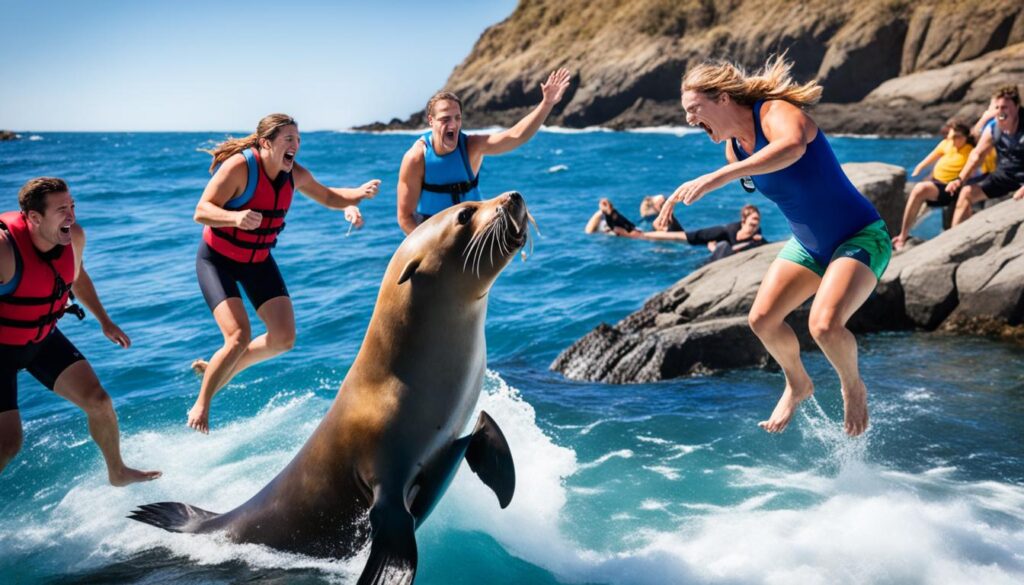
Sea lions are magnificent creatures that deserve our admiration and protection. While rare, sea lion attacks serve as a reminder of the importance of maintaining a safe distance and respecting their natural habitat. By fostering coexistence and understanding, we can enjoy the wonders of the ocean while preserving the delicate balance of life within it.
Sea Lion Life and Behavior
Sea lions are fascinating creatures known for their high intelligence and social nature. They live in large groups, especially during breeding and feeding seasons, where they exhibit complex behaviors and interactions.
Unlike their aggressive reputation, sea lions are generally not naturally aggressive and prefer to flee rather than fight when faced with a predator. This behavior makes them efficient at evading potential threats in their marine habitats.
Sea lion pups live together in a rookery, which is a breeding colony where adult females care for and protect the young. In the rookery, the pups have a safe space to nap, feed, and play while learning important skills for survival.
The Californian sea lion, in particular, is known for its friendly and curious nature, making it a popular species among visitors and researchers.
Sea lions are highly intelligent and social animals that exhibit fascinating behaviors in their natural habitats. Observing their interactions and group dynamics provides valuable insights into their complex lives.
Sea Lion Behavior in Their Natural Habitat:
- Swimming and diving abilities: Sea lions are agile swimmers and divers, equipped with powerful limbs and streamlined bodies. This allows them to navigate through the water with ease, reaching impressive speeds and depths.
- Communication: Sea lions use various vocalizations, such as barks and growls, to communicate and establish their social status within the group. These vocal cues are essential for coordinating hunting activities and maintaining group cohesion.
- Feeding patterns: Sea lions are opportunistic feeders, primarily targeting fish and other marine creatures. They employ different hunting strategies, including cooperative hunting and foraging in groups, to maximize their chances of catching prey.
- Hierarchy and social structure: Sea lions have a hierarchical social structure within their groups, with dominant males leading and defending their territories. Females play a significant role in nurturing and protecting their young, ensuring the survival of the next generation.
Understanding sea lion behavior is crucial for their conservation and the safety of both humans and sea lions. It allows us to appreciate their unique qualities and adapt our interactions to coexist harmoniously with these remarkable marine mammals.
| Behavior | Description |
|---|---|
| Swimming and Diving Abilities | Sea lions are agile swimmers and divers, capable of reaching impressive speeds and depths. |
| Communication | Sea lions use vocalizations such as barks and growls to communicate and establish social status. |
| Feeding Patterns | Sea lions are opportunistic feeders, targeting fish and employing different hunting strategies. |
| Hierarchy and Social Structure | Sea lions have a hierarchical social structure with dominant males leading and females nurturing the young. |
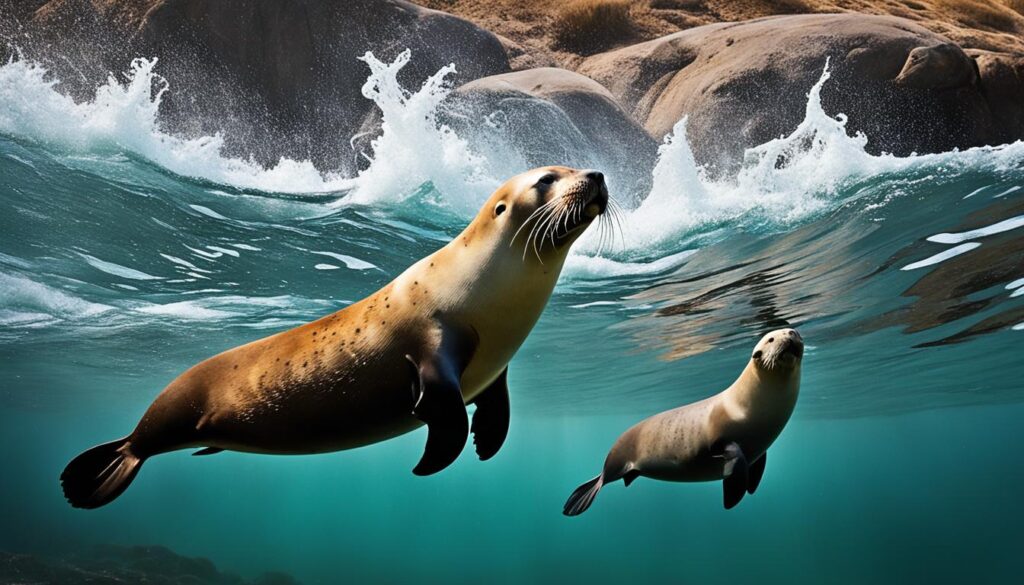
Swimming with Sea Lions: What You Need to Know
Swimming with sea lions can be a unique and enjoyable experience, allowing you to witness these fascinating creatures up close in their natural habitat. However, it’s vital to prioritize safety when engaging in this activity. Here’s what you need to know:
- Swim with a guide: It is highly recommended to swim with sea lions under the guidance of experienced professionals who understand their behavior and can ensure a safe interaction. They can also provide valuable insights and knowledge about these magnificent creatures.
- Choose the right location: Opt for open water areas where sea lions are accustomed to human presence. This ensures that the sea lions are familiar with swimmers and reduces the chance of aggressive behavior.
- Avoid mating season: Swimming with sea lions during their mating season is not advisable. During this time, the males can be territorial and may exhibit aggressive behavior to protect their breeding grounds.
- Keep your distance: Even though sea lions are generally friendly, it’s crucial to maintain a safe distance. Approaching too closely or attempting to touch them can cause anxiety and provoke defensive reactions.
- Respect their space: Remember, sea lions are wild animals, and their behavior can be unpredictable. Give them space and observe them from a distance, allowing them to go about their natural activities without disturbance.
“Swimming with sea lions offers a unique opportunity to witness their grace and agility in the water. By following safety guidelines and respecting their boundaries, we can ensure a memorable and positive experience for both humans and sea lions.”
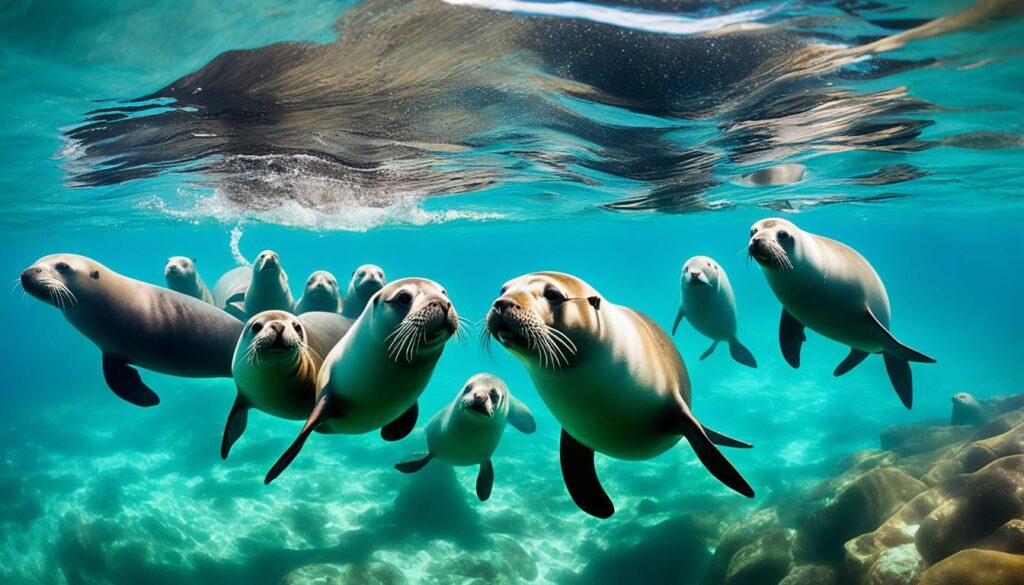
By understanding and adhering to these precautions, you can enjoy a safe and enriching experience swimming alongside these magnificent creatures. Always prioritize the welfare of the sea lions and ensure that your interactions with them are respectful and non-intrusive.
Defenses and Characteristics of Sea Lions
Sea lions possess a range of defenses and distinctive characteristics that enable them to thrive in their marine habitat. These remarkable creatures have evolved traits that aid in their survival and protection, making them formidable in the wild.
Defensive Mechanisms
Sea lions are equipped with sharp teeth and claws, serving as their primary defense mechanisms against threats. These formidable weapons allow them to fend off predators and ward off potential dangers.
Agility and Adaptability
Sea lions demonstrate exceptional agility both on land and in water. Their streamlined bodies and powerful flippers enable them to swim swiftly, dive efficiently, and navigate expertly through their aquatic environment.
These marine mammals also possess the remarkable ability to transition seamlessly from land to water. Their strong flippers and muscular bodies facilitate quick movements, allowing them to escape potential dangers and seek safety in the ocean.
Evading Predators
Sea lions have evolved the capability to evade aquatic predators such as orcas and great white sharks. Their speed and agility, combined with their expert diving skills, enable them to outmaneuver and elude these formidable hunters.
Size and Strength
Sea lions are known for their imposing size and strength. Adult male sea lions, in particular, can reach lengths of up to 10 feet and weigh over 800 pounds, making them a force to be reckoned with.
Behavior
Sea lions exhibit social behavior, often forming large colonies where they gather for breeding, feeding, and resting. These communities provide them with added protection against potential threats, as they can communicate, defend collectively, and watch out for one another.
Their intelligence and adaptability also contribute to their overall resilience. They are known to quickly learn new skills and adapt to changes in their environment, enhancing their chances of survival.
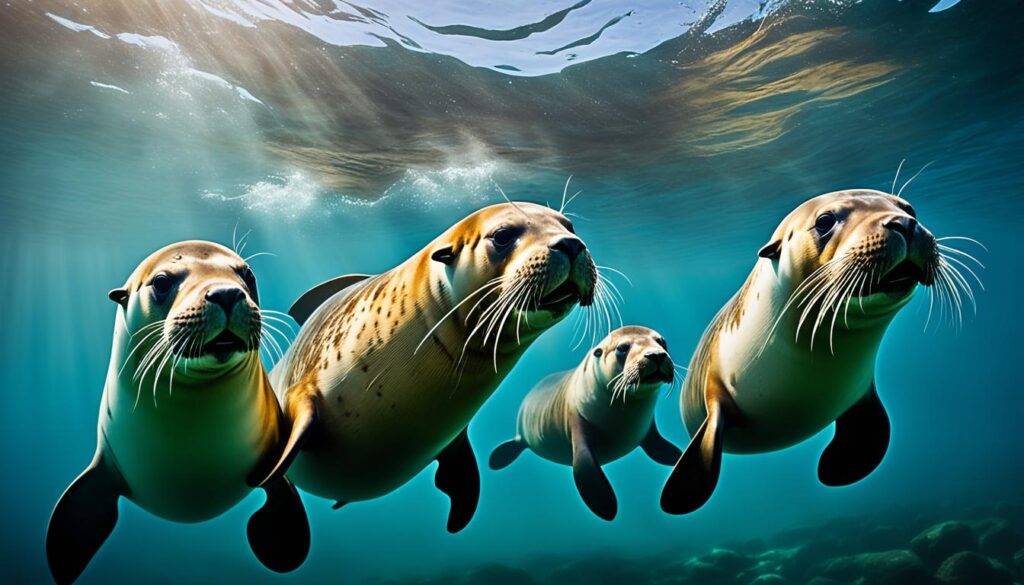
Sea lions are fascinating creatures that rely on their defenses, characteristics, and adaptability to navigate the challenges of their marine habitat. Their unique traits contribute to their success and make them a majestic species worth understanding and appreciating.
Conclusion
Sea lions are captivating creatures that possess unique physical characteristics and display intriguing behaviors. Despite their impressive size and power, sea lions are generally not dangerous to humans. However, it is crucial to exercise caution and prioritize safety when interacting with these marine mammals.
To ensure a harmonious coexistence, it is essential to maintain a safe distance from sea lions and respect their space. While sea lions typically exhibit friendly and playful behavior, certain circumstances may trigger aggression. By understanding sea lion behavior, their natural habitats, and taking necessary precautions, we can enjoy interactions with these magnificent creatures while minimizing potential dangers.
By respecting the boundaries of sea lions and adopting responsible practices, we can preserve their natural habitats and ensure the safety of both humans and sea lions. Remember, maintaining a safe distance and avoiding any actions that may threaten or provoke these animals is crucial. Let us embrace the marvel of sea lions while prioritizing their well-being and our own safety.
